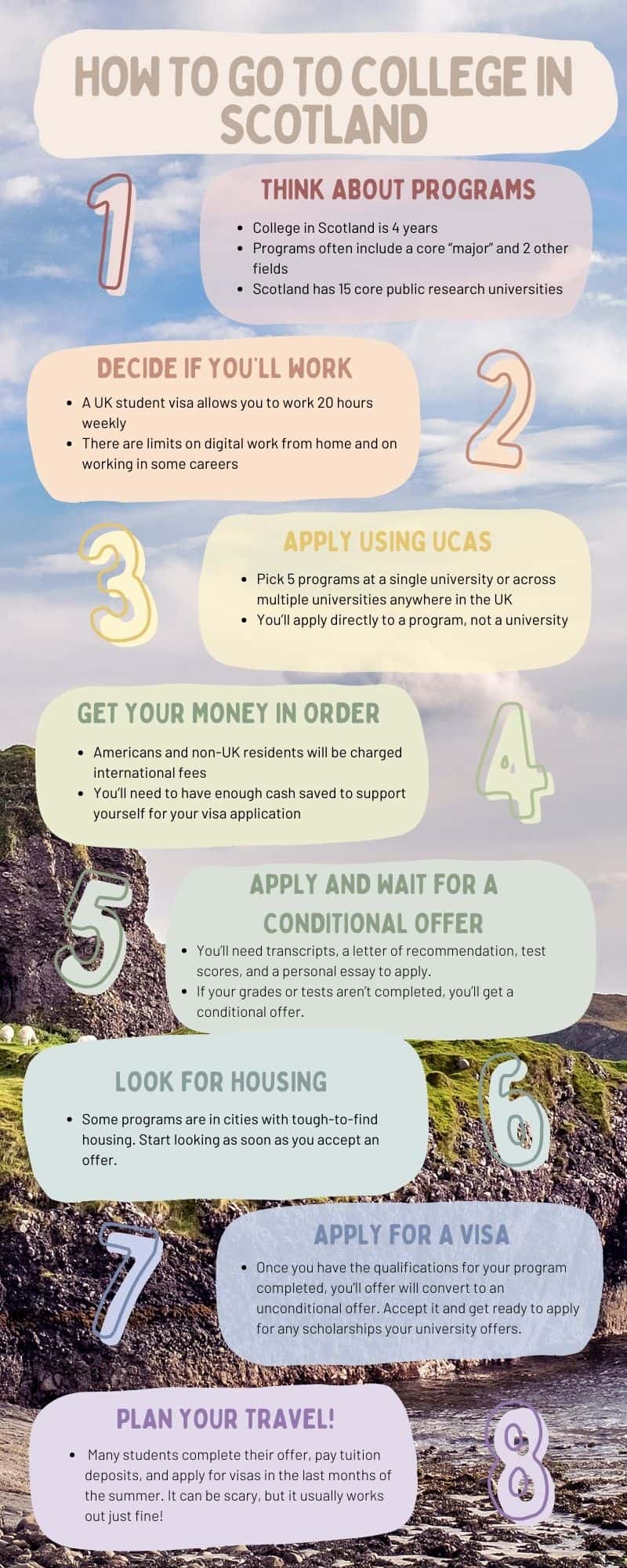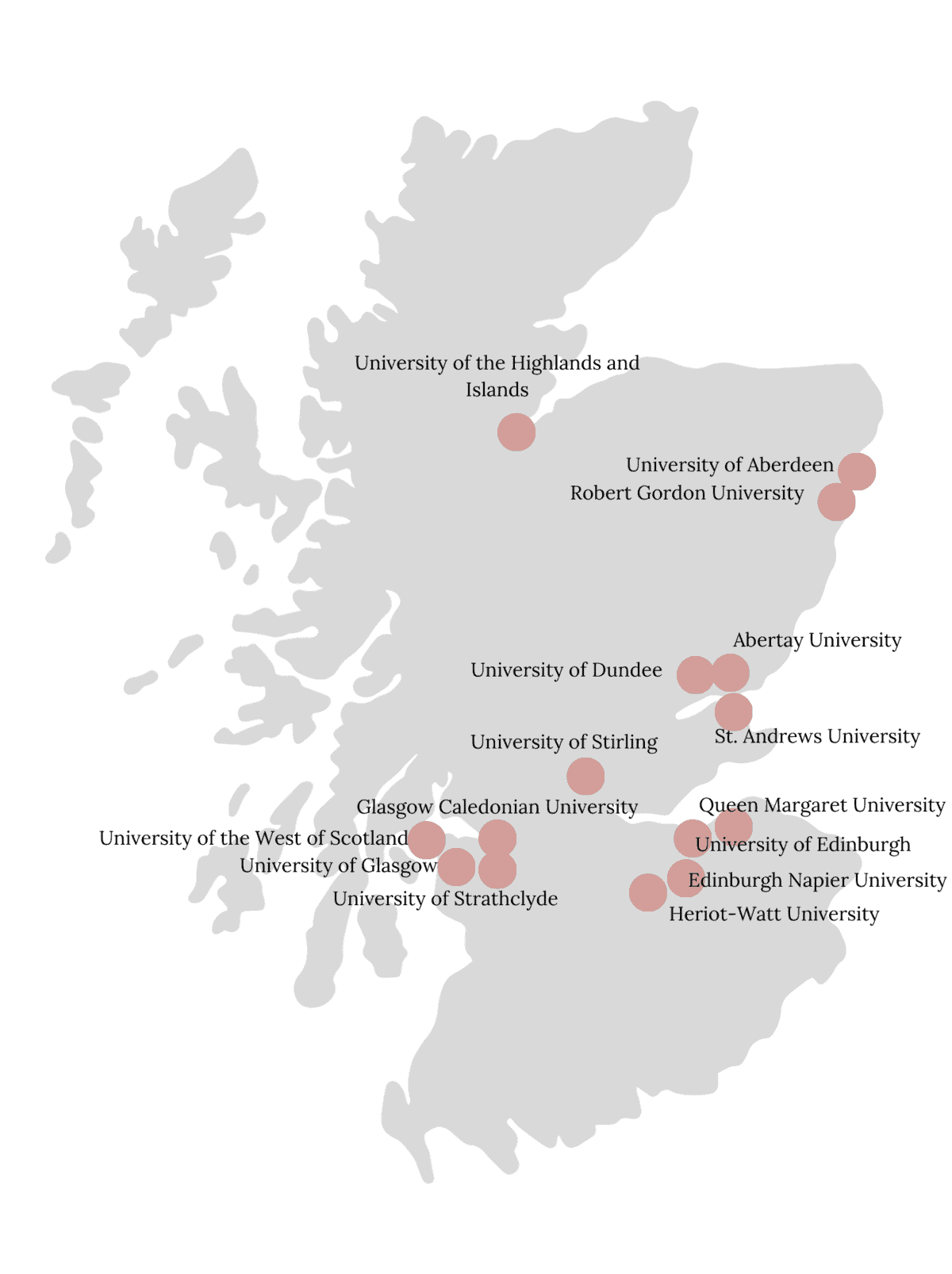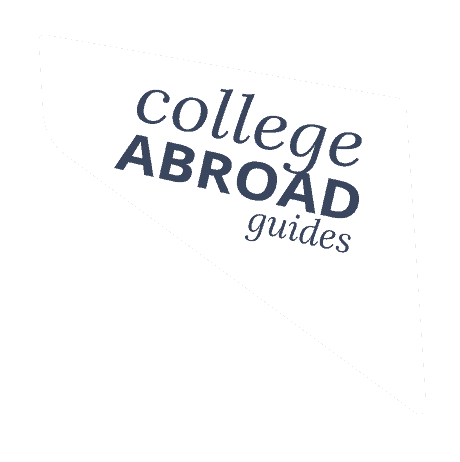
The Easy Basics You Need to Go to College in Scotland

- Originally published
- Last updated on March 5th, 2024 at 11:53 am
Table of Contents
The 101 Guide to Going to College in Scotland (for International Students)
If you want to go to college in Scotland, there’s good news. You’ll have less to figure out than most international options. Student life in Scotland and America are similar.
After all, the U.S. and Scotland share a common history, language, and even approach to education (but Scotland and England’s higher education systems are quite different, so be sure to find out how). This means that students find a lot of familiar features at Scottish schools:
-
- Study programs are four years long.
-
- Students will spend much of their early studies taking various classes across disciplines.
-
- Students specialize in a single subject later on.
-
- Even prices can be comparable. Explore which are the cheapest universities in Scotland to save the most.
-
- You get plenty of choices! Explore the universities of Scotland ranked by academics, cost, and happiness for international students.
Still, there are differences! From applying to visas, working, and costs, we talked to Scottish students to get the details.
Here’s the roadmap you’ll follow:

Why Scotland?
For American students, the transition to Scotland can be one of the easiest (at least from a culture-shock perspective).
- First, Scotland has been a leader in internationalizing its higher education programs. It currently attracts 50,000 international students annually.
- That popularity has spawned an industry that might be appealing for applicants. There are organizations at multiple universities that aid students in handling their transitions. They can help students secure visas, and book accommodation. Once the semester starts, they host events with other international students.
- Because of the 4-year degree structure, there are many opportunities to study abroad if you complete your degree in Scotland.
-
Scotland’s world-class educational institutions carry international clout. For example, the University of Edinburgh ranks #30 globally (according to Times rankings). St. Andrews, the University of Glasgow, the University of Edinburgh, and the University of Aberdeen are part of the UK’s prestigious group of ancient universities, scoring well on their long history of academic excellence. All were founded before 1600.
Overall, higher education in Scotland is a great choice for students wanting a broad-based program that resembles American schools but with the ambience of a European destination.
Can I go to college in Scotland?
Yes, non-EU students are welcome to apply.
However, they must pay tuition and fees. That doesn’t dissuade many students, and there are plenty of American students who attend Scottish bachelor’s programs.
The U.S. is a top country of origin for internationals in Scotland. It’s so obvious that at the University of St. Andrews, where you’re likely to hear American accents daily, students call their campus “the 51st state.”
Perhaps the Americanization of Scottish universities is because studying in Scotland is no harder under Brexit. On the other hand, European nationals now enroll much less. EU student applicants will have found Scotland is less accessible, as colleges now charge them the international rate.
However, every college in the country still welcomes international students.
Is Scotland good for international students?
Yes. Here are some reasons why:
- Scotland’s universities all feature programs taught in the native English language.
- English speakers can also communicate easily in shops, doctor’s offices, and student services.
- The quality of education is high, and based on a canon of research and scholars that will be familiar to US grad schools.
- Major cities have diverse residents where many students can find themselves represented and meet other internationals.
The drawbacks to school in Scotland are:
- The difficulty in working post-graduation without a job offer out of school. Students who don’t secure work right away may find it tough to find a job in their field. However, students can stay in Scotland for up to 2 years after completing their studies. They can do internships, volunteer, or work a short-term job.
- Although you can hang out a couple of years and try to find work, salaries are much lower in the UK compared to the US. The average starting salary of a Scottish grad is ~£30,937 (roughly $39,000). In London, grads can expect to earn £29,157. In the US, new grads can expect to earn much higher $58,862.
- Further, many students told us that diversity and inclusion are difficult outside the major cities. Overall, students felt warmly welcomed in Edinburgh and Glasgow.
People in Scotland are kind and welcoming and always ready to help. I had some concerns about being a lesbian in a smaller city. But Scotland is overall incredibly inclusive. Much more than I thought so it was a pleasant surprise.
Can international students work in Scotland?
Students from outside the UK will hold what’s called a “Tier 4 visa.” The visa restricts how much you work based on what kind of school you attend. For example, students from further education colleges will not be permitted to work at all (This probably won’t impact you — further education colleges are special schools that offer lower qualifications than universities. You can see a list of them here).
For the majority (degree-seeking undergrad students studying full-time), work is restricted to 20 hours a week. During school holidays, students can work full-time (36.5 hours per week).
Work restrictions include volunteer work as well as paid work.
Prohibited activities on a UK student visa include running any self-employed businesses you may have been running back home and continue to profit from (like selling digital products). There are also prohibitions on jobs like yoga instructor, dj, and professional soccer player, so read up on the student visa rules (and fees) to determine how you’ll be able to fit your work life into your studies in Scotland.
I applied for a couple different programs. I knew where I wanted to be, but not what I wanted to study. I was really worried doing a personal statement that worked for such different programs but I was accepted at both so it worked out.
How many universities can you apply to in Scotland?
The online Universities and Colleges Admissions Centre (UCAS) system will let applicants pick up to five programs in the entirety of the UK — feel free to stick to Scotland. Distribute your applications however you like — for example, pick 5 programs at a single university or 5 programs at 5 different universities.
This is a general rule for undergraduate studies. UCAS limits student applications to four programs in veterinary science, medicine, and dentistry.
How many universities are in Scotland?
There are 19 universities in Scotland. These higher education institutions (HEIs) receive funding from the Scottish Funding Council.
Ancient Universities: University of Edinburgh, University of St. Andrews, University of Aberdeen, and the University of Glasgow
Chartered Universities (that came into being through royal charter): Dundee, Stirling, Open University, Strathclyde, Heriot-Watt
New Universities (which became universities under the 1992 Act): Glasgow Caledonian, Abertay, Robert Gordon, Queen Margaret Edinburgh, Edinburgh Napier, the University of the West of Scotland, and the University of the Highlands & Islands
Special Universities (small, specialty universities): Glasgow School of Art, Royal Conservatoire of Scotland, and Scotland’s Rural College (which has multiple campuses specializing in agriculture)

How much is College in Scotland?
The cheapest college in Scotland is Queen Margaret University, where four years of tuition costs Americans £28,000. That’s not the norm! The second cheapest, the University of the Highlands and Islands, charges internationals a total of £55,920.
In general, college in Scotland can be affordable, even for international students paying tuition, compared to the U.S. Rough annual tuition runs $14,000 – $24,000 (you’ll pay in pounds, so watch the exchange rates).
Scottish students study for free. Before Brexit, so did EU students since they must be offered the same tuition as the “home” students. That rule is dead.
Brexit has meant that EU students will not pay the same tuition as Scottish students any longer, making Scotland a less attractive option for their studies. there are 16,000 EU internationals making up a hefty chunk of Scotland’s 50,000 international students.
Some students who started their studies prior to COVID-19 and Brexit’s finaliation continue to enjoy free tuition through their studies. However, new students surely have reason to look elsewhere. That has meant collapsing demand from the EU and, therefore, more international spaces for American students. The downside is there are fewer EU study companions and less overall diversity.
“Fee status” has a lot to do with paying the international fee. If you think you qualify as a Scottish or UK resident, you pay lower tuition fees. While this is theoretically a national status, some universities make their own calls, with some students reporting they did or did not attend based on getting the designation at some of their top choices but not others.
Cost of living is high in Scotland. In 2022, students spent about £924 per month (check the exchange rate: this can range from $924-about $1350), including all expenses, like housing, bills, food, transportation, entertainment, and books.
Some scholarships are available to international students, so don’t write off Scotland’s high price tag until you’ve investigated your options for funding your education.
Is university free in Scotland?
Post-Brexit, Scotland comes at a premium price and is by no means free for students coming from outside of Scotland. Scotland has comparable annual tuition prices typically falling between in- and out-of-state tuition costs at US universities. In Scotland, annual tuition costs average from £20,000 to £30,000 per year ($25,000 to $38,000).
International tuition in Scotland ranges from a grand total (4 years) of £28,000 at Queen Margaret University to £184,380 at St. Andrews.
Cost Comparison:
Let’s say you want to attend one of the most “average” universities in Scotland for price: the University of Strathclyde. You’ll pay $84,714 in tuition and $20,934 for the least expensive accommodation. That’s a total of $105,648 over 4 years.
If you’d have chosen the University of Colorado – Boulder, your tuition would be $38, 314 (totalling $153,256) plus $27,320 for the least expensive dorm. You’ll wind up spending a total of $180,576 (out of state).
In state? You’ll spend less overall in the US: $77,304.
When does university start in Scotland?
Scottish universities typically run on semesters but start late compared to many US schools. Edinburgh, for instance, hosts welcome week in mid-September, and exam week is not over until days before Christmas. St. Andrews runs on a similar semester schedule.
Spring semester looks more familiar to American students, with classes from mid-January until late May (the semesters seem to start a couple days earlier than in the US rather than waiting out the MLK Jr. holiday). Remember, that means you won’t have as long a break as a typical American university over the winter holidays.
How to apply to colleges in Scotland
The application process starts by registering with the UK’s common portal: the Universities and Colleges Admissions Centre (UCAS). You can apply for multiple programs at once, but there are fees that increase with the number of programs you apply to. International students, EU students, and Scottish students all use this portal. You can apply to up to five degree courses in the UK with this system (that includes England, Scotland, Wales, and Northern Ireland schools).
Make sure you check out your favorite programs and include their desired qualifications on your UCAS application. There is an international page detailing what American students should have accomplished in high school in order to qualify for admission, from AP scores to SAT/ACT scores.
Upload grades, AP coursework, test scores, letters of recommendation, and a personal statement that covers all your programs (this part can be tricky if you’re applying for a few different programs).
Preparing for college means researching what you’ll need to achieve in order to study at a Scotland university.
Scotland: An exciting mix of courses and culture
Overall, studying in Scotland is a great way to experience the culture of another country. You’ll get real-life international experience and study multiple subjects with foundation coursework just like back home.
Check out our guidebooks (and especially check out the Scotland Guidebook) for detailed descriptions of English-taught programs in Europe, geared toward American students, with interviews from students. They’re all in one WiFi-free place and include more bonus material than the online versions below.
Related Posts

Jessica Share
Jessica is the writer, Ph.D., and mom-of-an-abroad-student-in-the-UK at the helm of College Abroad Guides. When she's not asking college students where the coolest place to hang out in their city is, she's figuring out how she can make $60 imported Greek oregano potato chips and £50 British bacon potato chips appear on her doorstep for the cost of a local bag of Lay's.


































